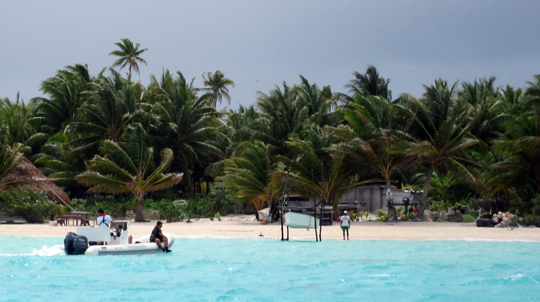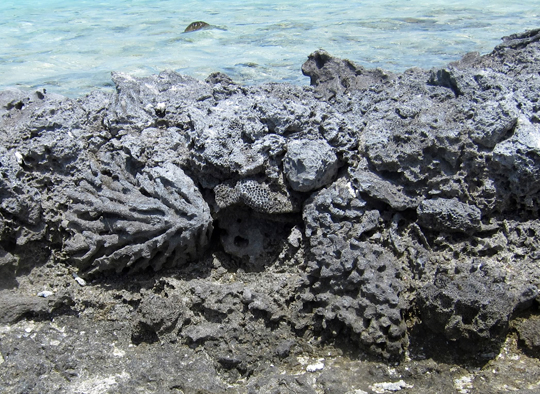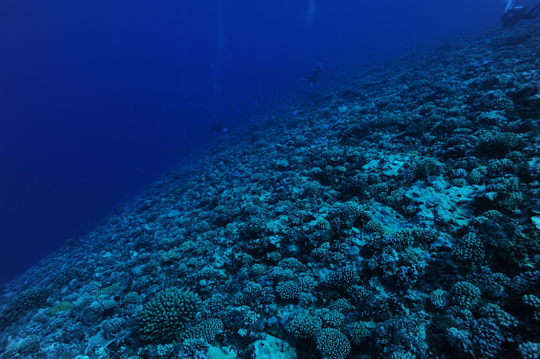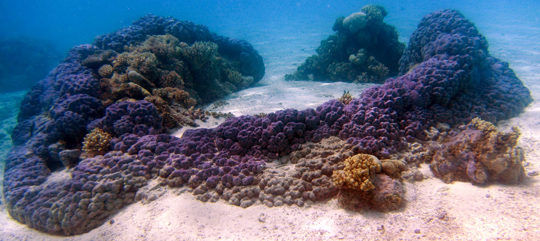The first site in the Society Islands to be visited in French Polynesia is Mopelia (Maupihaa). This coral atoll has a well-developed reef encircling a lagoon in which numerous bommies occur. Islands sit atop the reef and host sea bird colonies while sea turtles use the beaches for nesting grounds.

Under the water’s surface, impressive numbers of coral colonies inhabit the outer slope of the reef before it drops off into deep waters. Even the shallow reef flat supports a diverse array of life.
The Process of Seafloor Mapping
One of the Global Reef Expedition’s goals is to create benthic habitat and bathymetric maps of the remote locations visited by the researchers. To accomplish this, researchers must go through the process of seafloor mapping. The ground-truthing team, consisting of Dr. Sam Purkis and doctoral student and Living Oceans Foundation Fellow Jeremy Kerr, surveys the water depth with an acoustic depth sounder and gathers video and digital pictures of the landscape to record the marine habitats present in the area. They incorporate this information into the map-making process via statistical models combining the ground-truth data with satellite imagery, which was acquired prior to field research. The resulting geospatial products show the distribution of marine habitats and the seafloor topography.
Prior to the maps’ completion, the ground-truthing team develops a general sense of site’s landscape characteristics. For example, Mopelia has three main landscape features: a lagoon, a reef flat, and a reef slope.

The central lagoon is predominantly filled with muddy sediments and isolated coral bommies. It ranges in depth from 5 meters (16 feet) to 35 meters (113.4 feet). The reef flat is no deeper than 3 meters (9.5 ft) and contains sand, macroalgae, and coral rubble. This is where the islands are located. One can also find exposed reef framework where coral skeletons, clam shells, and cementing algae have been incorporated into the reef matrix.

The reef slope begins just below the water’s surface and slopes to depths of 40 meters (130 ft) before quickly dropping off. This area has much greater live coral cover than any other habitat.

Seafloor Mapping of Society Islands, French Polynesia
The landscape observed at Mopelia in both the satellite imagery and through field observations reflects a recurring theme in geologic studies of coral reefs. The overall structure formed by reef growth over millennia resembles a bucket. The outer edge, where coral and other calcifying organisms grow most vigorously, aggrades quicker than the inner portion of the platform, which slowly fills with sediment. Over time, the different aggradation rates result in a marked difference in water depth throughout the atoll leading to the bucket shape. Even though this phenomenon occurs at many locations, the resulting seafloor topography can vary substantially and the causes for the different expressions are not totally clear. Additionally, it occurs at multiple scales. For example, colonies and bommies can take the same shape where the top and center part of the structure is covered in algae while the edges contain live coral and continue growing. The information gathered during this mission will help illuminate the factors driving this process.

(Photos/Images by: Jeremy Kerr)
To follow along and see more photos, please visit us on Facebook! You can also follow the expedition on our Global Reef Expedition page, where there is more information about our research and team members.